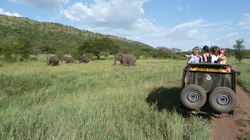Teaching philosophy

At the core of my teaching philosophy lies a passion for conservation biology and an commitment to student empowerment. With over 37 courses taught, primarily in wildlife conservation, my approach to education is rooted in experiential learning, critical thinking, and fostering a collaborative research environment. I have developed and led courses that blend theoretical knowledge with crucial skills in wildlife management and spending significant time mentoring students in intensive field research. My curriculum is threefold: imparting foundational concepts in ecology and conservation, teaching quantitative research methods in the field such as landscape-scale surveys and behavioral studies in shared landscapes, and honing analytical skills through state-of-the-art techniques in computer labs.
The fusion of teaching and research is pivotal to my pedagogy. Students are not just learners but active researchers, contributing to publications that often extend beyond their academic tenure, as evidenced by continuous collaborations and publications in peer-reviewed journals.
Inclusivity is a cornerstone of my educational philosophy. I am proud of mentoring a diverse array of students, including those from various gender identities and geographic backgrounds. This diverse collaboration enriches the learning experience for all and aligns with my objective to foster a culture of diversity, equity, and inclusivity within academia. My teaching philosophy is also adaptable, embracing tools like R for statistical analysis to enhance the educational experience. Student feedback is the compass that guides the continuous refinement of my teaching methods. I am dedicated to nurturing the next generation of conservationists who are equipped to face global challenges, with a teaching model that is as dynamic and diverse as the ecosystems we strive to protect.
The fusion of teaching and research is pivotal to my pedagogy. Students are not just learners but active researchers, contributing to publications that often extend beyond their academic tenure, as evidenced by continuous collaborations and publications in peer-reviewed journals.
Inclusivity is a cornerstone of my educational philosophy. I am proud of mentoring a diverse array of students, including those from various gender identities and geographic backgrounds. This diverse collaboration enriches the learning experience for all and aligns with my objective to foster a culture of diversity, equity, and inclusivity within academia. My teaching philosophy is also adaptable, embracing tools like R for statistical analysis to enhance the educational experience. Student feedback is the compass that guides the continuous refinement of my teaching methods. I am dedicated to nurturing the next generation of conservationists who are equipped to face global challenges, with a teaching model that is as dynamic and diverse as the ecosystems we strive to protect.
